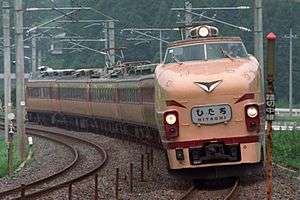159 series
The 159 series (159系) was an electric multiple unit (EMU) train type operated by Japanese National Railways (JNR) from 1961 until 1980.[1] They were originally designed for and used on school excursion trains running between Tokyo and the Nagoya area via the Tokaido Main Line.[1]
| 159 series | |
|---|---|
| In service | 1961–1980 |
| Constructed | 1961–1962 |
| Refurbished | 1975 |
| Number built | 16 cars (3 sets) |
| Number in service | None |
| Number preserved | None |
| Formation | 4/8 cars per set |
| Operator(s) | JNR |
| Depot(s) | Ogaki |
| Specifications | |
| Car body construction | Steel |
| Doors | 2 per side |
| Electric system(s) | 1,500 V DC |
| Track gauge | 1,067 mm (3 ft 6 in) |
Exterior
Broadly based on the earlier 155 series trains, the 159 series trains were also initially painted in the JNR excursion train livery of "lemon yellow" and "light scarlet".[1]
Formations
The fleet consisted of one 8-car and two 4-car sets, formed as shown below, and based at Ogaki Depot in Gifu Prefecture.[2]
8-car set
| Designation | Tc | M' | M | T | T | M' | M | Tc |
|---|---|---|---|---|---|---|---|---|
| Numbering | KuHa 159 | MoHa 158 | MoHa 159 | SaHa 159 | SaHa 159 | MoHa 158 | MoHa 159 | KuHa 159 |
- The MoHa 154 cars were each equipped with one lozenge-type pantograph.[2]
4-car sets
| Designation | Tc | M' | M | Tc |
|---|---|---|---|---|
| Numbering | KuHa 159 | MoHa 158 | MoHa 159 | KuHa 159 |
- The MoHa 158 cars were each equipped with one lozenge-type pantograph.[2]
Key
- Tc: driving trailer
- T: intermediate trailer
- M: intermediate motor with control equipment
- M': intermediate motor
History
The 159 series sets entered service from 2 April 1961 on Komadori (こまどり) school excursion services running on the Tokaido Main Line between Shinagawa Station in Tokyo and Ogaki Station in Aichi Prefecture.[3] Trains carried headboards on the front with the name of the train.[1] An additional four-car set was delivered in 1962 to allow 16-car formations to be run.[2]
The Komadori school excursion services were discontinued in 1973, and the 159 series were reassigned to use on "rapid" limited-stop services and charter train services, repainted into the Shonan livery of orange and green.[2]
The entire fleet was withdrawn from service by fiscal 1980.[1] No 159 series vehicles have been preserved.[4]
See also
References
- Matsumoto, Norihisa (April 2014). "初登場の修学旅行電車" [The first school-excursion trains]. Japan Railfan Magazine (in Japanese). 54 (636): 126–131.
- 写真とイラストで見る国鉄急行型電車のすべて [JNR Express EMUs in pictures]. Japan: Neko Publishing Ltd. 29 November 2013. pp. 40–43. ISBN 978-4-7770-1532-0.
- Teramoto, Mitsuteru (23 July 2001). 国鉄・JR列車名大辞典 [JNR & JR Train Name Encyclopedia]. Tokyo, Japan: Chuoshoin Publishing Co., Ltd. p. 239. ISBN 978-4-88732-093-2.
- Sasada, Masahiro (September 2012). 国鉄&JR保存車大全 [JNR & JR Preserved Rolling Stock Complete Guide]. Tokyo, Japan: Ikaros Publications Ltd. p. 127. ISBN 978-4863206175.
